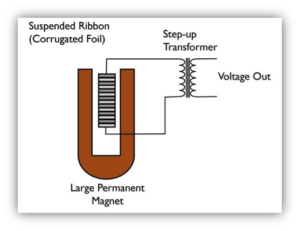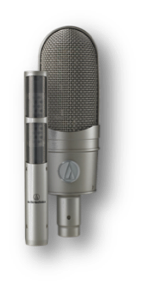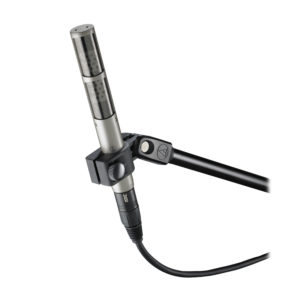What Are the Differences Between the Microphones that Audio-Technica Offers? (Part 2 - Ribbon Mics)
Answer: In our previous Question of the Week we began looking at the different types of microphones and focused on the moving-coil dynamic microphone. This week we’ll look at the ribbon microphone, which traditionally is also considered a dynamic microphone, but one that is made of different materials than the moving-coil. Ribbon microphones have a bidirectional polar pickup pattern and utilize a very thin foil ribbon element that is suspended within the field of a large permanent magnet. Change in air pressure (sound) moves the ribbon element within the magnet’s magnetic field, generating a positive voltage. The rebound movement of the ribbon element in the magnetic field generates a negative charge. Step-up transformers are then used to boost the voltage to a useable microphone level.
[caption id="attachment_1770" align="aligncenter" width="300"] Figure 1[/caption]
Figure 1[/caption]
One downside of ribbon microphones had always been their large size and weight, a result of the large magnet within. Another was the fragility of the ribbon element, which could be easily damaged by excessive air pressures such as from someone blowing into the microphone. Exposure to phantom power or other such voltage could also destroy the ribbon element. With these limitations in mind, Audio-Technica engineers created the AT4080 and AT4081 Phantom-powered Bidirectional Ribbon Microphones, which breathed new life into the ribbon microphone by making it more durable and compatible with preamps.
 Audio-Technica’s MicroLinear™ design, used in both the AT4080 and AT4081, incorporates 2-micron-thick diaphragm material and dual-ribbon construction with baffle plate, which helps address common ribbon microphone limitations. The frequency response of traditional ribbon microphones resonated at 7 kHz which may be less than desirable for certain recording applications. The MicroLinear design has an extended frequency response for a more natural reproduction of the sonic spectrum. A metallic ultra-fine mesh was added to the ribbon element imprint to greatly decrease the ribbon element’s susceptibility to excessive air pressure. Additionally, an extremely powerful N50 rare earth magnet and phantom-powered electronics were added to the output, providing an output signal level similar to condenser microphones along with a stable impedance to prevent excessive loading with certain preamps.
Audio-Technica’s MicroLinear™ design, used in both the AT4080 and AT4081, incorporates 2-micron-thick diaphragm material and dual-ribbon construction with baffle plate, which helps address common ribbon microphone limitations. The frequency response of traditional ribbon microphones resonated at 7 kHz which may be less than desirable for certain recording applications. The MicroLinear design has an extended frequency response for a more natural reproduction of the sonic spectrum. A metallic ultra-fine mesh was added to the ribbon element imprint to greatly decrease the ribbon element’s susceptibility to excessive air pressure. Additionally, an extremely powerful N50 rare earth magnet and phantom-powered electronics were added to the output, providing an output signal level similar to condenser microphones along with a stable impedance to prevent excessive loading with certain preamps.
Ribbon microphones are commonly used with electric guitars, vocals, and brass and woodwind instruments. Dynamic microphones were often the microphone of choice on guitar cabinets, but in recent years, ribbon microphones have again gained in popularity, chosen for their distinct “vintage sound.” You can see the AT4080 in use with a saxophone in our Basic Recoding Techniques: Saxophones video.
We’ll look next time at condenser microphones and see how they capture sound in relation to moving-coil dynamic and ribbon microphones. If you need help finding the Audio-Technica microphone that best suit your needs, please contact the Audio Solutions Department. And be sure to join us next time for another Question of the Week.
